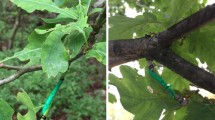Summary
The bilberry (Vaccinium myrtillus L.), is the dominant plant in the field layer of many boreal forests in northern Sweden. It is utilized by several herbivorous insect larvae as food (i.e. Lepidoptera: Geometridae, Tortricidae and Hymenoptera: Symphyta). Total density of insect larvae was 63% lower where birds had access to larvae compared to exclosures. Larvae with a feeding behaviour which exposes them to birds (geometrids and sawflies) showed a pronounced reduction in density when exposed to bird predators. Density of larvae with a concealed feeding behaviour (tortricids) was unaffected by birds. The frequency of larval damage to bilberry annual shoots was significantly higher in areas where larval density was high due to exclusion of birds. I concluded that birds have the potential to heavily modify the interaction between bilberry and insect larvae.
Similar content being viewed by others
References
Ahti T, Hämet-Ahti L, Jalas J (1968) Vegetation zones and their sections in north-western Europe. Ann Bot Fenn 5:169–211
Crawley MJ (1983) Herbivory, Blackwell Scientific Publications, Oxford
Dayton PK (1984) Processes structuring some marine communities: are they general? In: Abele G, Simberloff DS, Strong DR, Thistle A (eds) Ecological communities: conseptual issues and the evidence. Princeton University Press, Princeton, pp 181–197
Ebeling S (1978) Nordsvenska skogstyper. Sveriges Skogsvårdsförb Tidskr 76:340–381
Gradwohl J, Greenberg R (1982) The effect of a single species of avian predator on the arthropods of aerial leaf litter. Ecology 63:581–583
Holmes RT, Schultz JC, Nothnagle P (1979) Bird predation on forests insects: an exclosure experiment. Science 206:462–463
Mills EL, Forney JL, Wagner KJ (1987) Fish predation and its cascading effect on the Oneida lake food chain. In: Kerfoot CW, Sih A (eds) Predation. University Press of New England, London, pp 118–131
Oksanen L, Ericson L (1987) Preface: Why do we care about predation and parasitism. Oikos 50:274–275
Otvos J (1979) The effects of insectivorous bird activities in forest ecosystem. In: Dickson JG, Connor RN, Fleet RR, Jackson JA, Kroll JC (eds) The role of insectivorous birds in forest ecosystems, London, pp 341–374
Price PW, Bouton CE, Gross P, McPhernon BA, Thompson JN, Weis AE (1979) Interactions among three trophic levels: Influence of plants on interactions between insect herbivores and natural enemies. Ann Rev Ecol Syst 11:41–65
Risch SJ, Carroll CR (1982) Effect of a keystone predaceous ant, Solenopsis geminata, on arthropods in a tropical agroecosystem. Ecology 63:1979–1983
Solomon DM, Glen DM, Kendall DA, Milsom NF (1976) Predation of overwintering larvae of codling moth (Cydia pomonella (L.)) by birds. J Appl Ecol 13:341–353
Strauss SY (1987) Direct and indirect effects of host-plant fertilization on an insect community. Ecology 68:1670–1678
Taylor RJ (1984) Predation, Chapman & Hall London
Torgersen TR, Campbell RW (1982) Some effects of avian predators on the western spruce budworm in north central Washington. Environ Entomol 11:429–431
Torgersen TR, Mason RR, Paul GH (1983) Predation on pupae of Douglas-fir Tussock Moth, Orygia pseudotsugata (McDunnough) (Lepidoptera: Lymantriidea). Environ Entomol 12:1678–1682
White TCR (1984) The abundance of invertebrate herbivores in relation to the availability of nitrogen in stressed food plants. Oecologia 63:90–105
Author information
Authors and Affiliations
Rights and permissions
About this article
Cite this article
Atlegrim, O. Exclusion of birds from bilberry stands: impact on insect larval density and damage to the bilberry. Oecologia 79, 136–139 (1989). https://doi.org/10.1007/BF00378251
Received:
Issue Date:
DOI: https://doi.org/10.1007/BF00378251




